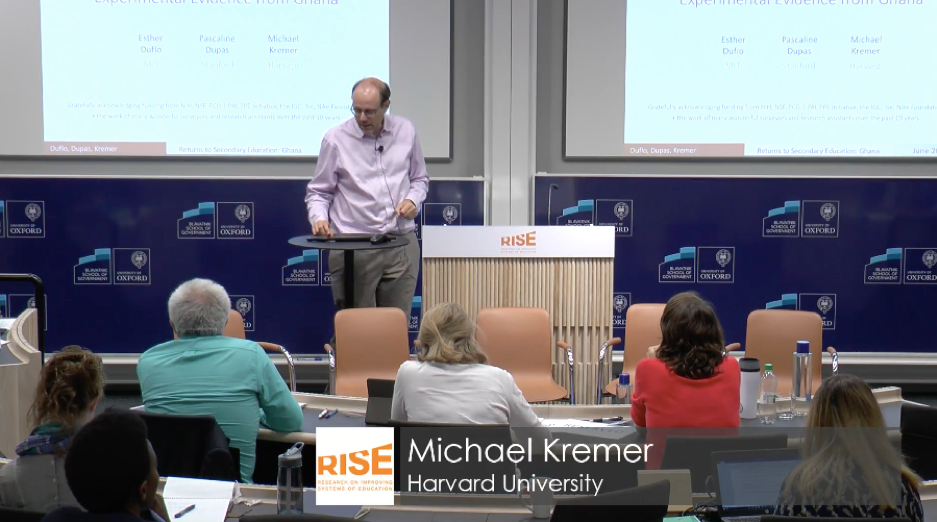Blog
RISE Annual Conference - A Personal Reflection
In 2016, as a graduate student of Public Policy at the University of Oxford, I remember being thrilled to attend the RISE Annual Conference, and on the suggestion of Dr. Clare Leaver (my economics professor at the time), I presented a poster on the Right to Education in India. It was a fantastic experience to hear from the likes of Prof. Lant Prittchet, Prof. Paul Glewwe, Dr. Deon Filmer, etc. Hearing the presenters discuss their rigorously researched papers at the RISE Conference has always been an enriching experience, one which is easy to remember. Although all of the studies presented at the 2016 conference were great, I found the presentations by Dr. David Evans of the World Bank (who proposed setting standards to teacher training programmes as his research found that providing complementary materials tended to show higher gains) and by Dr. Geeta Kingdon of UCL (who discussed the political economy of education reforms in India and suggested that teacher effort may continue to be low despite high salaries and training) to be particularly insightful.
Year after year, I have seen fantastic research presented at the RISE Annual Conference and the 2018 event was no exception. The Conference was buzzing with exceptional researchers and representatives from a variety of organisations. The packed lecture theatre at the Blavatnik School of Government (University of Oxford) hosted participants from 26 different countries and showcased 29 presentations spread across 8 sessions. The attendees participated in discussions on curriculum; information and assessment (system in/coherence and evidence on accountability); methods (classroom observation and ethnographic research); teachers (motivation and support); financing; and the role of the private sector.
For my third RISE Conference, I have highlighted a few presentations that closely align with my own interests. (Forgive me for being selective, I couldn’t do justice to all 29 presentations in this short blog! And please do note that the RISE Conference Report, discussing all of the papers, will be available on the RISE website soon, together with a series of blogs taking a more in-depth look at the conference).
Michelle Kaffenberger (RISE/World Bank): Estimating the Impact of Women’s Education on Fertility, Child Mortality, and Empowerment When Schooling Ain’t Learning (co-authors Lant Pritchett of the Center for Global Development/RISE and Justin Sandefur of the Center for Global Development/RISE)
The authors analysed the Demographic and Health Surveys (DHS) for 129 survey rounds across 54 countries to find that while 6 years of schooling does not significantly improve learning outcomes across all developing countries, it does significantly reduce fertility (by 50 percent) and child mortality (by 68 percent). These results suggest that the non-pecuniary returns from female education are much higher than previously believed.

Tarun Jain (Indian School of Business): Reshaping Adolescents’ Gender Attitudes: Evidence from a School-Based Experiment in India (co-authors Diva Dhar of the Bill & Melinda Gates Foundation and Seema Jayachandran of Northwestern University)
The team evaluated an intervention (RCT) aimed at eroding support for restrictive gender norms, specifically a multi-year school-based intervention in Haryana, India, that engaged adolescents in classroom discussions about gender equality. They found that the intervention significantly improved adolescents’ gender attitudes in comparison to other correlates of their attitudes, such as their parents’ attitudes. The research also found more gender-equitable behaviour self-reported by the participants after the intervention; for example, boys reported helping out more with household chores.

Baela Jamil and Saba Saeed (Idara-e-Taleem-o-Aagahi): Ins and Outs of Rolling Out Teaching at the Right Level (TaRL) in Pakistan
Following Pratham India’s pedagogy “Teaching at the Right Level” (TaRL) approach, this paper evaluated the impact of placing out of school children in a learning camp of 45-60 days. A total of 20,800 children were provided intensive bursts of remedial education across 530 schools in 3 provinces of Pakistan. The study found that TaRL helped children improve their learning outcomes. Recipients of the program (treatment school children) outperformed control group children across English and Maths.
Ricardo Estrada (CAF-Development Bank of Latin America): Predicting Individual Wellbeing Through Test Scores: Evidence from a National Assessment in Mexico(co-authors Rafael de Hoyos and Maria Jose Vargas of the World Bank)
The paper used national standardized exam scores in Mexico to construct longitudinal datasets. The study tracked students from the end of primary to the end of lower and upper secondary school, then to university and labor market participation up to two years after graduation from upper secondary. The study found that test scores are a strong predictor of future education and labor market outcomes. The study also found that the relationship between Grade 6 test scores and future education outcomes goes beyond family background. These results show that, despite their limitations, large-scale standardized tests can capture skills that are important for future individual wellbeing.
Abhijeet Singh (Stockholm School of Ecnomics/RISE): Testing for What? Audit Study Evidence on the Reliability and Effectiveness of Large-Scale Test-Based Accountability in India (co-author Karthik Muralidharan of University of California, San Diego/NBER/RISE)
The study conducted an audit of 500 schools in Madhya Pradesh, India to collect student-level data on independent learning assessments, with a subset of the same questions as administered in the official assessments. The team found a substantial upwards manipulation in officially-reported levels of student achievement. The reported percentage of students answering a question correctly in official assessments is higher for all common questions (by as much as 100 percent) in comparison to audit data on the same students. Further, despite this high degree of manipulation in the reported levels of achievement, the study found considerable agreement in the ranking of schools and students across official and independently-collected student assessments. Additionally, the remedial action plans based on the state assessment exercise (which were supposed to be triggered at the school and student level) were ineffective.

Karthik Muralidharan (University of California, San Diego/NBER/RISE): Understanding the Flailing State: Experimental Evidence from a Large-Scale School Governance Improvement Program in India (co-author Abhijeet Singh of the Stockholm School of Economics/RISE)
The study evaluated the impact of the implementation of an ambitious large scale school governance program in Madhya Pradesh, India (randomised over 5800 schools where 1900 schools were in treatment and the rest acted as control schools). The intervention consisted of several global best practices in school governance and included three main components: comprehensive school assessments by external school inspectors leading to customized school improvement plans, regular follow ups on progress with ongoing monitoring and support, and leveraging ICT tools to make both assessments and progress visible throughout the education system. The paper found that while the program meaningfully evaluated school quality and was properly implemented, there was no impact on teacher absence, teacher effort in classrooms, student engagement, or the engagement of School Management Committees. Furthermore, the intervention had no impact on student learning outcomes.
Naureen Karachiwalla (International Food Policy Research Institute): Educator Incentives and Educational Triage in Rural Primary Schools (co-authors Daniel O. Gilligan of International Food Policy Research Institute, Ibrahim Kasirye of Economic Policy Research Centre, Adrienne Lucas of University of Delaware/NBER, and Derek Neal of University of Chicago/NBER/IZA)
The authors studied an experiment in rural Uganda that sought to reduce dropout rates in Grade 6 and 7 by offering bonus payments to Grade 6 teachers for the performance of each of her students relative to comparable students in other schools. This Pay for Percentile (PFP) incentive system resulted in raising attendance rates two school years. The study found that the attendance gains were driven primarily by outcomes in treatment schools that provide textbooks for Grade 6 math students. In these same schools, students whose initial skill levels prepared them to use Grade 6 math texts enjoyed significant gains in math achievement. The researchers found little evidence that PFP improved attendance or achievement in schools without books even though PFP had the same impact on reported teacher effort in schools with and without books.
Michael Kremer (Harvard University):The Impact of Free Secondary Education: Experimental Evidence from Ghana (co-authors Esther Duflo of MIT and Pascaline Dupas of Stanford)
The paper evaluated the impact of free secondary schooling in Ghana. In an experiment, 682 secondary school scholarships were awarded by lottery among 2,064 Ghanaian students (aged 17 on average) who could not immediately enrol in school mostly due to lack of funds, despite being admitted to a specific school and track. The researchers collected follow-up data until 2016 to document downstream impacts by age 25. The study found that scholarship winners were 26 percentage points (55 percent) more likely to complete secondary school, obtained 1.26 more years of secondary education, scored greater on a reading and math test, and adopted more preventative health behaviour, with reduced fertility rates. The study also found that scholarship winners were more likely to have enrolled in tertiary education and more likely to have positive earning gains. For students admitted to vocational tracks (comprising 60 percent of the sample) scholarships did not increase tertiary education, which simplifies the interpretation of labour market outcomes. For students admitted to academic majors, the study found that scholarships increased the chance of having enrolled in tertiary education.

Vijay Kumar (Blavatnik School of Government, University of Oxford): Choice for the Poor or Poor Choice? Experimental Evidence on the Impact of India’s School Choice Policy
India’s Right to Education (RTE) Act of 2009 introduced a unique choice policy. Under this policy the Government reserves 25 percent of places in entry grades of all private schools for children from disadvantaged households. The government pays the tuition costs to the private schools. Families from certain underprivileged social groups (castes) and those below a specified income cut-off are defined as disadvantaged and eligible for the free places. The stated objectives of the policy are to provide better quality education to disadvantaged children and to desegregate the Indian schooling system. The paper investigated the impact of the 25 percent mandate on children’s learning and psychosocial outcomes. To study the impact of the 25 percent mandate, the presenter sampled over 1600 children in Karnataka, where the government invited disadvantaged and eligible families to apply for a lottery that allocated RTE free places in private schools to the winners. In the study, the presenter found that within his sample, 99 percent of lottery winners and 93 percent of the lottery losers enrolled in private schools. This is striking and suggests that most of the policy applicants were in fact default private school goers. From its inception, the 25 percent mandate was therefore mistargeted. The study found that after 1.5 years of schooling, there was no statistically significant difference in the outcomes (test scores) of those children who won the lottery and attended a private school as part of the 25 percent mandate and those who lost the lottery and did not receive a free, mandated place at a private school.
This was just a snapshot of the many fantastic presentations at the RISE Annual Conference 2018. As mentioned previously, the full conference report with a summary of all the presentations will be published in due course via the RISE website, along with a series of in-depth blogs on each of the sessions. In the meantime, you can review discussions on all 29 papers on this twitter thread by Justin Sandefur (Center for Global Development and RISE Directorate Member) and view the presentations on the RISE YouTubeChannel.
Author bios:
RISE blog posts and podcasts reflect the views of the authors and do not necessarily represent the views of the organisation or our funders.

